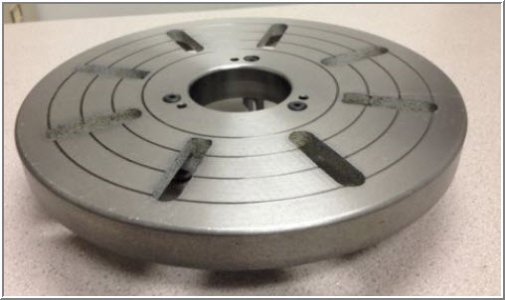This is cast iron so i had no lubricant, i cant remember the dimensions but its around 11/16 wide x.300 deep with just under 1/2 wide male slot, for the speed I ran the same for both end mill and T-slotter and it was around 550SFM i hand fed it very gently. Here is the finished project, all i have to do now is make the T- Slots. Clamps convert the faceplate into an extra-large, extra-adaptable independ-ent chuck, when they are mounted in place with bolts through the slots in the faceplate, or through holes which have been drilled. On slides or tables with T-slots, they are equally useful for side-gripping components as in machine vices.
go to the home page
go to the page above this one
Lathe – workholding – faceplate
If turning between centers is the oldest form of turning then turning using a faceplate must be the second oldest.Often, in old pictures of big lathes, the lathe has just a faceplate.
T Slot Plate

fig photo of old lathe with a faceplate
Though the faceplate is a very simple idea, it can, sometimes with some difficulty, be made to do a very wide range of jobs.

fig modern lathe fitted with a face plate
Key features of the faceplate
Assuming the face plate is fitted securely to the spindle there are three key features that it needs. Firstly it is round and, secondly, it has a flat surface. It should be obvious that both of this can be produced simply by turning the faceplate when fitted to the spindle. Thirdly it needs some method of fixing a workpiece or workholding device onto it.
On old faceplates the faceplate was cast roughly to the required shape but with holes or slots in it. The workpiece could then be bolted onto the face plate. Modern faceplates are often fitted with T-slots in them.
Holding a workpiece onto a faceplate
In all of the following methods of holding a workpiece on a faceplate there is one common factor. It is often easier to fit the workpiece when the faceplate is lying, horizontal, on the bench rather than is vertical on the lathe.
It is often not possible to fit the workpiece completely but it is usually possible to fit the workpiece sufficiently so that when the faceplate is fitted to the lathe there is no risk of the workpiece falling onto the bed of the lathe.
Often workpieces fitted to a faceplate might not be balanced. In some cases it might not be possible to balance it. Change gears for the lathe can sometimes be used as counterweights. However most workpieces can be turned safely if the speed of rotation is slow enough.
Holding the workpiece using clamps

The workpiece can be held onto the faceplate by using the same sort of clamps as might be used on a milling machine. However the T-slots on the faceplate are often distinctly smaller than those on a milling machine of a similar size to the lathe being used. A further limitation is that whereas a workpiece on a milling table can hang over the edge, on a faceplate the workpiece is limited by the bed of the lathe.

T Slot Plate 28
The real problem is that the T-slots are often at right angles to each other. When using these it is seldom possible to place the clamping bolts where they are best used.
One solution to this is to fit an auxiliary plate to the faceplate. This plate is fitted with a rectangular array of threaded holes which can take the clamping bolts.
fig auxiliary plate
(Yes – this is the same plate as is used elsewhere on a rotary table – and for exactly the same reason.)
Holding the workpiece using an angle plate
Many angle plates have slots going one way on one side and going the other way on the other side. If, for example the T-slot on the face plate is horizontal then the slot on the angle plate touchinf the faceplate should be vertical. This means the angle plate can be easily moved horizontally or vertically.
The space on the faceplate is maximised by using an angle plate where the inside is also machined flat. The workpiece is fitted “inside” the angle plate.

fig workpiece held on faceplate using the inside of an angle plate
Holding the workpiece using a Keats block
